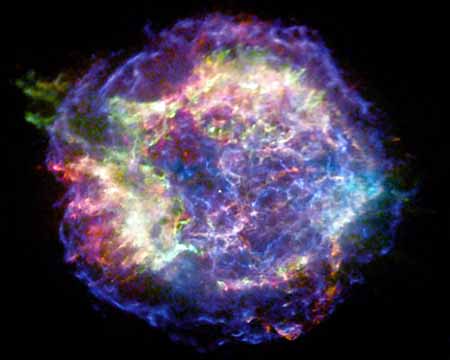

A supernova is a stellar explosion that is more energetic than a nova. Supernovae (plural) are extremely luminous and cause a burst of radiation that often briefly outshines an entire galaxy, before fading from view over several weeks or months. During this short interval a supernova can radiate as much energy as the Sun is expected to emit over its entire life span. Several large stars within the Milky Way have been suggested as possible supernovae within the next million years. These include Rho Cassiopeiae, Eta Carinae, RS Ophiuchi, U Scorpii, VY Canis Majoris, Betelgeuse, Antares, and Spica.
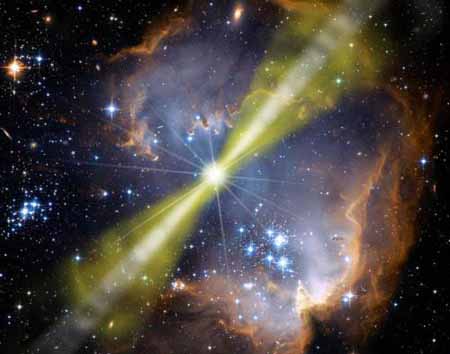
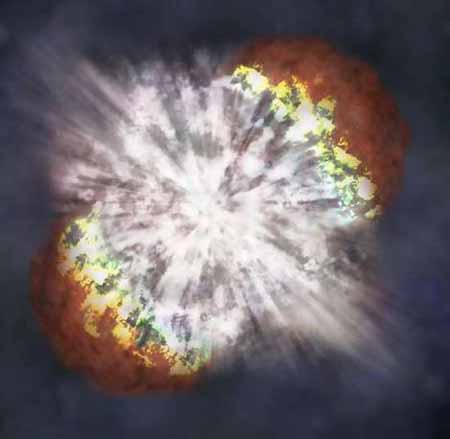
The explosion expels much or all of a star's material at a velocity of up to 30,000 kms (10% of the speed of light), driving a shock wave into the surrounding interstellar medium. This shock wave sweeps up an expanding shell of gas and dust called a supernova remnant.
Nova (plural novae) means "new" in Latin, referring to what appears to be a very bright new star shining in the celestial sphere; the prefix "super-" distinguishes supernovae from ordinary novae, which also involve a star increasing in brightness, though to a lesser extent and through a different mechanism. The word supernova was coined by Swiss astrophysicist and astronomer Fritz Zwicky, and was first used in print in 1926.
Several types of supernovae exist. Types I and II can be triggered in one of two ways, either turning off or suddenly turning on the production of energy through nuclear fusion. After the core of an aging massive star ceases generating energy from nuclear fusion, it may undergo sudden gravitational collapse into a neutron star or black hole, releasing gravitational potential energy that heats and expels the star's outer layers.
Alternatively a white dwarf star may accumulate sufficient material from a stellar companion (either through accretion or via a merger) to raise its core temperature enough to ignite carbon fusion, at which point it undergoes runaway nuclear fusion, completely disrupting it. Stellar cores whose furnaces have permanently gone out collapse when their masses exceed the Chandrasekhar limit, while accreting white dwarfs ignite as they approach this limit (roughly 1.38 times the solar mass).
White dwarfs are also subject to a different, much smaller type of thermonuclear explosion fueled by hydrogen on their surfaces called a nova. Solitary stars with a mass below approximately 9 solar masses, such as the Sun, evolve into white dwarfs without ever becoming supernovae.
Although no supernova has been observed in the Milky Way since 1604, supernovae remnants indicate on average the event occurs about once every 50 years in the Milky Way. They play a significant role in enriching the interstellar medium with higher mass elements.
Furthermore, the expanding shock waves from supernova explosions can trigger the formation of new stars.
Hipparchus' interest in the fixed stars may have been inspired by the observation of a supernova (according to Pliny).
The earliest recorded supernova, SN 185, was viewed by Chinese astronomers in 185 AD. The brightest recorded supernova was the SN 1006, which was described in detail by Chinese and Islamic astronomers.
The widely observed supernova SN 1054 produced the Crab Nebula. Supernovae SN 1572 and SN 1604, the latest to be observed with the naked eye in the Milky Way galaxy, had notable effects on the development of astronomy in Europe because they were used to argue against the Aristotelian idea that the universe beyond the Moon and planets was immutable.
Johannes Kepler began observing SN 1604 on October 17, 1604. It was the second supernova to be observed in a generation (after SN 1572 seen by Tycho Brahe in Cassiopeia).
Since the development of the telescope the field of supernova discovery has extended to other galaxies, starting with the 1885 observation of supernova S Andromedae in the Andromeda galaxy. Supernovae provide important information on cosmological distances.
During the twentieth century successful models for each type of supernova were developed, and scientists' comprehension of the role of supernovae in the star formation process is growing. American astronomers Rudolph Minkowski and Fritz Zwicky developed the modern supernova classification scheme beginning in 1941.
In the 1960s astronomers found that the maximum intensities of supernova explosions could be used as standard candles, hence indicators of astronomical distances. Some of the most distant supernovae recently observed appeared dimmer than expected. This supports the view that the expansion of the universe is accelerating.
Techniques were developed for reconstructing supernova explosions that have no written records of being observed. The date of the Cassiopeia A supernova event was determined from light echoes off nebulae,[22] while the age of supernova remnant RX J0852.0-4622 was estimated from temperature measurements[23] and the gamma ray emissions from the decay of titanium-44.
In 2009 nitrates were discovered in Antarctic ice deposits that matched the times of past supernova events.
Because supernovae are relatively rare events within a galaxy, occurring about once every 50 years in the Milky Way, obtaining a good sample of supernovae to study requires regular monitoring of many galaxies.
Supernovae in other galaxies cannot be predicted with any meaningful accuracy. Normally, when they are discovered, they are already in progress. Most scientific interest in supernovae - as standard candles for measuring distance, for example - require an observation of their peak luminosity. It is therefore important to discover them well before they reach their maximum. Amateur astronomers, who greatly outnumber professional astronomers, have played an important role in finding supernovae, typically by looking at some of the closer galaxies through an optical telescope and comparing them to earlier photographs.
Towards the end of the 20th century astronomers increasingly turned to computer-controlled telescopes and CCDs for hunting supernovae. While such systems are popular with amateurs, there are also professional installations such as the Katzman Automatic Imaging Telescope.
Recently the Supernova Early Warning System (SNEWS) project has begun using a network of neutrino detectors to give early warning of a supernova in the Milky Way galaxy.Neutrinos are particles that are produced in great quantities by a supernova explosion, and they are not significantly absorbed by the interstellar gas and dust of the galactic disk.
Supernova searches fall into two classes: those focused on relatively nearby events and those looking for explosions farther away. Because of the expansion of the universe, the distance to a remote object with a known emission spectrum can be estimated by measuring its Doppler shift (or redshift); on average, more distant objects recede with greater velocity than those nearby, and so have a higher redshift. Thus the search is split between high redshift and low redshift, with the boundary falling around a redshift range of z = 0.1-0.3[33] - where z is a dimensionless measure of the spectrum's frequency shift.
High redshift searches for supernovae usually involve the observation of supernova light curves. These are useful for standard or calibrated candles to generate Hubble diagrams and make cosmological predictions. Supernova spectroscopy, used to study the physics and environments of supernovae, is more practical at low than at high redshift. Low redshift observations also anchor the low-distance end of the Hubble curve, which is a plot of distance versus redshift for visible galaxies. h3
A near-Earth supernova is a supernova close enough to the Earth to have noticeable effects on its biosphere. This would need to be nearer than about 100 to 3000 light-years away, depending upon type and energy - different figures have been suggested.
Gamma rays from a supernova would induce a chemical reaction in the upper atmosphere converting molecular nitrogen into nitrogen oxides, depleting the ozone layer enough to expose the surface to harmful solar and cosmic radiation. This has been proposed as the cause of the Ordovician-Silurian extinction, which resulted in the death of nearly 60% of the oceanic life on Earth.
In 1996 it was theorized that traces of past supernovae might be detectable on Earth in the form of metal isotope signatures in rock strata. Iron-60 enrichment was later reported in deep-sea rock of the Pacific Ocean.
In 2009, elevated levels of nitrate ions were found in Antarctic ice, which coincided with the 1006 and 1054 supernovae. Gamma rays from these supernovae could have boosted levels of nitrogen oxides, which became trapped in the ice.
Type Ia supernovae are thought to be potentially the most dangerous if they occur close enough to the Earth. Because these supernovae arise from dim, common white dwarf stars, it is likely that a supernova that can affect the Earth will occur unpredictably and in a star system that is not well studied. One theory suggests that a Type Ia supernova would have to be closer than a thousand parsecs (3300 light-years) to affect the Earth.
The closest known candidate is IK Pegasi. Recent estimates predict that a Type II supernova would have to be closer than eight parsecs (26 light-years) to destroy half of the Earth's ozone layer.
Several large stars within the Milky Way have been suggested as possible supernovae within the next million years. These include Rho Cassiopeiae, Eta Carinae, RS Ophiuchi, U Scorpii, VY Canis Majoris, Betelgeuse, Antares, and Spica. Many Wolf-Rayet stars, such as Gamma Velorum, WR 104, and those in the Quintuplet Cluster, are also considered possible precursor stars to a supernova explosion in the 'near' future.
The nearest supernova candidate is IK Pegasi (HR 8210), located at a distance of 150 light-years. This closely orbiting binary star system consists of a main sequence star and a white dwarf 31 million kilometres apart. The dwarf has an estimated mass 1.15 times that of the Sun. It is thought that several million years will pass before the white dwarf can accrete the critical mass required to become a Type Ia supernova. Read more ...
JWST Detects Record-Breaking Supernova That Erupted Right at The Cosmic Dawn Science Alert - December 10, 2025

A faint, tiny flash of red light glimpsed at the Cosmic Dawn more than 13 billion years ago has smashed the record for the earliest supernova ever observed. It appeared just 720 million years after the Big Bang, smack bang during the Epoch of Reionization, soaring past the previous record-holder, a supernova that exploded when the Universe was 1.8 billion years old. And here's the kicker: The light from the new record-breaker wasn't even boosted by the massive gravitational bending of space-time usually needed to magnify light that distant.
An Exploding Star Just Changed What We Know About the Origins of Life SciTech Daily - December 4, 2025

"Why are we here?" remains one of the oldest questions humans have asked. One way scientists approach this is by examining how the elements that make up everything around us first formed. Many elements are known to arise within stars and in the explosive aftermath of supernovae, which scatter this material throughout space. However, the sources of several important elements have remained unclear. Scientists using the XRISM X-ray satellite have uncovered unexpectedly high amounts of chlorine and potassium in the Cassiopeia A supernova remnant, solving a long-standing mystery about the origins of these life-important elements.
JWST Confirms Day-Long Gamma-Ray Burst Was The Most Energetic Event Humanity Has Witnessed IFL Science - October 23, 2025
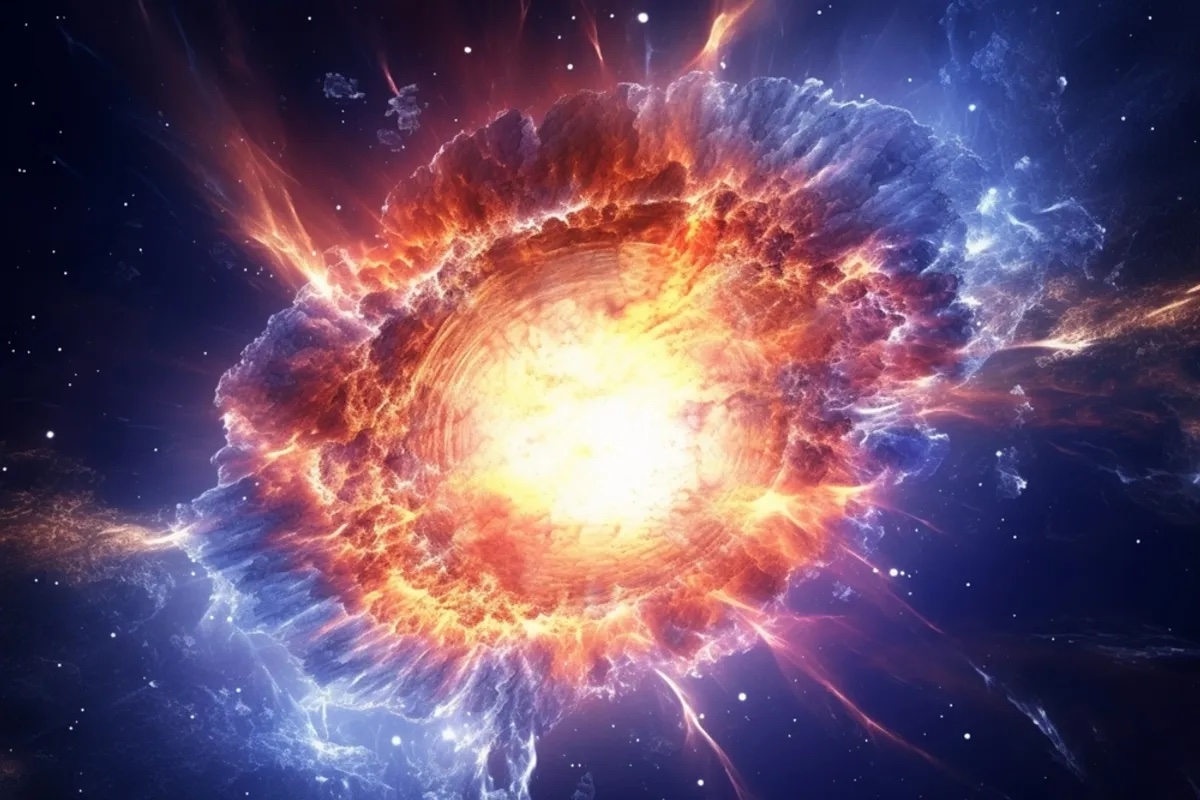
GRB 221009A, has been dubbed the BOAT (Brightest Of All Time) for being so far off the range predicted by other GRBs that we should only see something like it every thousand years. GRB 250702B proved there is more than one way for such events to be extraordinary, in the form of rapidly repeating explosions.
Scientists find evidence of 'supernova graveyard' at the bottom of the sea and possibly on the surface of the moon Live Science - March 19, 2025

After finding the debris of two colliding stars swimming in the ocean, researchers are after more evidence from the lunar soil.
New Study of Supernovae Data Suggests That Dark Energy is an Illusion Universe Today - January 2, 2025

Dark energy is central to our modern understanding of cosmology. In the standard model, dark energy is what drives the expansion of the Universe. In general relativity, itÕs described by a cosmological constant, making dark energy part of the structure of space and time. But as weÕve gathered more observational evidence, there are a few problems with our model. For one, the rate of cosmic expansion we observe depends on the observational method we use, known as the Hubble tension problem. For another, while we assume dark energy is uniform throughout the cosmos, there are some hints suggesting that might not be true. Now a new study argues weÕve got the whole thing wrong. Dark energy, the authors argue, doesnÕt exist.
Astronomers take a close look at a dandelion-shaped supernova and zombie star PhysOrg - October 24, 2024

In 1181, a new star shone near the Cassiopeia constellation for six months before disappearing. This event, recorded as a "guest star" by Chinese and Japanese observers almost a millennium ago, has puzzled astronomers for centuries. It is one of a few supernovae to be documented before the invention of telescopes. In addition, it remained an "orphan" the longest, meaning that none of the celestial objects visible today could be assigned to it.
NASA Releases 20-Year Video Of The Most Amazing Star We Know - Eta Carinae IFL Science - September 27, 2023
For 18 years in the mid-19th century, the leaderboard of brightest stars was upended when the previously faint star Eta Carinae entered the charts, peaking several times in second place, behind only Sirius. The world had seen nothing like it since KeplerÕs supernova in 1604, and Eta Carinae stayed bright a great deal longer. The star responsible is now shrouded in dust thrown off in that event, frustrating optical astronomers in their quest to understand what happened, but instruments operating in other parts of the spectrum, like X-rays, have more success.
Invisible supernovas called 'bosenovas' may be exploding all around us, new research suggests Live Science - July 27, 2023
What happens when an invisible star dies? It erupts in an invisible explosion, of course. New research describes how these unseen 'bosenovas' may behave.
JWST Catches Sight of a Rare Star on The Brink of Going Supernova Science Alert - March 16, 2023
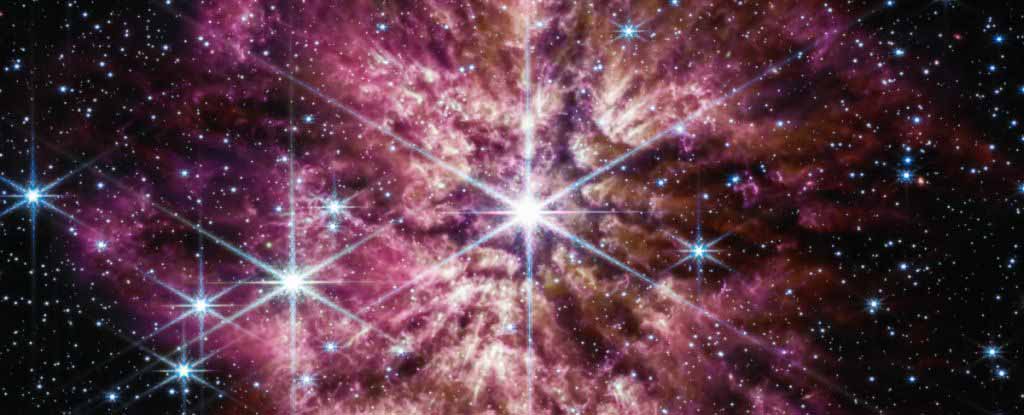
In a new image from the JWST, the spectacular final throes of a star nearing the end of its life are revealed in all their intricate detail.
Supernova Explosions Reveal Precise Details of Dark Energy and Dark Matter SciTech Daily - October 26, 2022
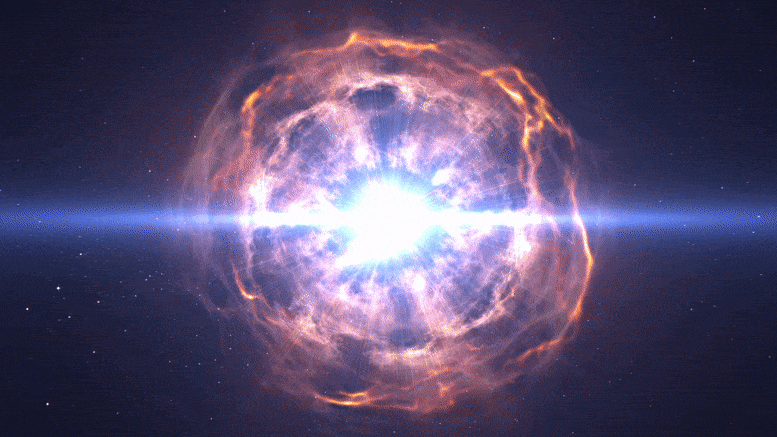
An analysis of more than two decadesÕ worth of supernova explosions convincingly boosts modern cosmological theories and reinvigorates efforts to answer fundamental questions. A powerful new analysis has been performed by astrophysicists that places the most precise limits ever on the composition and evolution of the universe. With this analysis, dubbed Pantheon+, cosmologists find themselves at a crossroads.
Extraterrestrial stone brings first supernova clues to Earth PhysOrg - May 16, 2022
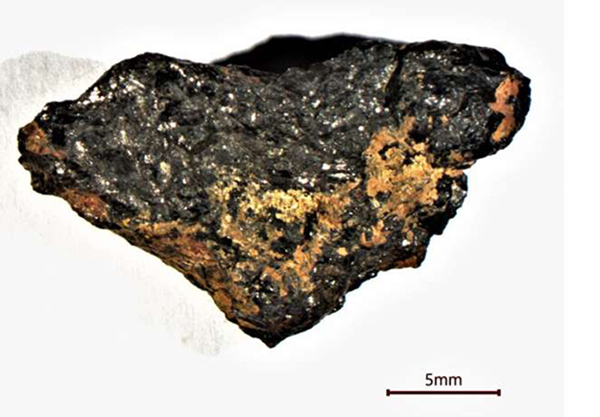
New chemistry "forensics" indicate that the stone named Hypatia from the Egyptian desert could be the first tangible evidence found on Earth of a supernova type Ia explosion. These rare supernovas are some of the most energetic events in the universe. Their hypothesis about Hypatia's origin starts with a star: A red giant star collapsed into a white dwarf star. The collapse would have happened inside a gigantic dust cloud, also called a nebula. That white dwarf found itself in a binary system with a second star. The white dwarf star eventually "ate" the other star. At some point the "hungry" white dwarf exploded as a supernova type Ia inside the dust cloud. After cooling, the gas atoms which remained of the supernova Ia started sticking to the particles of the dust cloud...
This Unstable Double Binary Star System Could Implode Into a Type Ia Supernova Science Alert - May 16, 2022
Multiple star systems are very common in the Milky Way. While most of these systems are binary systems consisting of two stars, others contain three, four, or even six stars. These systems tend to be pretty stable since unstable systems tend to break apart or merge fairly quickly, but sometimes you can get a kind of meta-stable system. One that lasts long enough for stars to evolve while still being stable in the end. And that end could be a supernova. It all comes down to gravitational dynamics. In Newtonian physics, two orbiting masses in isolation are always stable. The only paths they can have are elliptical orbits. This is why simple binaries are the most common multiple star systems. Once you have three or more masses, things get more complicated. So complicated that there isn't an exact solution to the three-body problem, much less four or more.
Strange 'reverse shock wave' supernova is exploding in the wrong direction Live Science - April 1, 2022
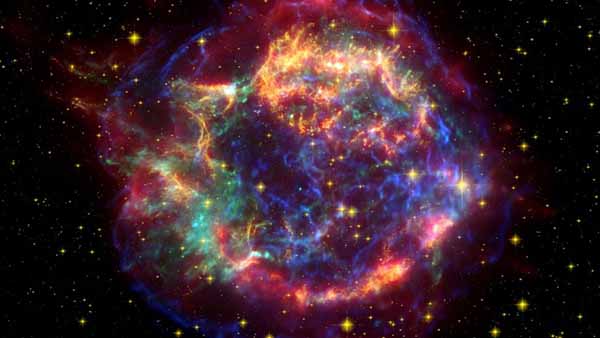
A powerful shock wave traveling through a cloud of gas left behind by the explosive death of a star has a bizarre quirk: Part of it is traveling in the wrong direction, a new study reveals. In the study, researchers found that the shock wave is accelerating at different rates, with one section collapsing back toward the origin of the stellar explosion, or supernova, in what the study authors call a "reverse shock."
Cassiopeia A is a nebula, or gas cloud, left behind by a supernova in the constellation Cassiopeia, around 11,000 light-years from Earth, making it one of the closest supernova remnants. The nebula, which is around 16 light-years wide, is made of gas (mainly hydrogen) that was expelled both before and during the explosion that ripped apart the original star. A shock wave from that explosion is still rippling through the gas, and theoretical models show that this shock wave should be expanding evenly, like a perfectly rounded balloon that's constantly being inflated.
Our Planet Is Traveling Through The Debris of Ancient Supernovae Science Alert - April 21, 2021
Radioactive dust deep beneath the ocean waves suggests that Earth is moving through a massive cloud left behind by an exploded star. Continuously, for the last 33,000 years, space has been seeding Earth with a rare isotope of iron forged in supernovae. It's not the first time that the isotope, known as iron-60, has dusted our planet. But it does contribute to a growing body of evidence that such dusting is ongoing - we are still moving through an interstellar cloud of dust that could have originated from a supernova millions of years ago. Iron-60 has been the focus of several studies over the years.
It has a half-life of 2.6 million years, which means it completely decays after 15 million years - so any samples found here on Earth must have been deposited from elsewhere, since there's no way any iron-60 could have survived from the formation of the planet 4.6 billion years ago. And deposits have been found.
Nuclear physicist Anton Wallner of the Australian National University previously dated seabed deposits back to 2.6 million and 6 million years ago, suggesting that debris from supernovae had rained down on our planet at these times. But there's more recent evidence of this stardust - much more recent. It's been found in the Antarctic snow; according to the evidence, it had to have fallen in the last 20 years. For The First Time, a Rare Type of Space Dust Has Been Found in Antarctic Snow
Scientists claim to have solved a longstanding mystery as to how cosmic dust, the building blocks of stars and planets, forms across the Universe. PhysOrg - February 20, 2019
The dust is primarily formed in stars and is then blown off in a slow wind or a massive star explosion.
Up until now, astronomers have had little understanding as to why so much cosmic dust exists in the interstellar medium, with theoretical estimates suggesting it should be obliterated by supernova explosions. A supernova is an event that occurs upon the violent death of a star and is one of the most powerful events in the Universe, producing a shockwave which destroys almost anything in its path.
Newly discovered supernova complicates origin story theories Science Daily - November 30, 2018
A supernova discovered by an international group of astronomers provides an unprecedented look at the first moments of a violent stellar explosion. The light from the explosion's first hours showed an unexpected pattern, which astronomers analyzed to reveal that the genesis of these phenomena is even more mysterious than previously thought. A supernova discovered by an international group of astronomers provides an unprecedented look at the first moments of a violent stellar explosion. The light from the explosion's first hours showed an unexpected pattern analyzed to reveal that the genesis of these phenomena is even more mysterious than previously thought.
Research reinforces role of supernovae in clocking the universe PhysOrg - January 4, 2017
How much light does a supernova shed on the history of universe? The findings support a widely held theory that the expansion of the universe is accelerating and such acceleration is attributable to a mysterious force known as dark energy. The findings counter recent headlines that Type Ia supernova cannot be relied upon to measure the expansion of the universe.
Star snapped before and after nova explosion BBC - August 18, 2016
Astronomers have captured rare images of a tiny star before, during and after it exploded as a "classical nova". In this type of binary system, a white dwarf sucks gas from a much bigger partner star until it blows up - about every 10,000 to one million years. Now, a team has caught one in the act using a telescope in Chile. Even though it is 20,000 light-years away - a terribly faint pinprick of light barely visible among brighter stars, even in magnified images - this was a rare opportunity to study the build-up and aftermath of a classical nova.
Nearby supernova dazzles astronomers BBC - January 23, 2014
An exploding star has been spotted in the night sky - the closest supernova to Earth that has been seen in decades. The dramatic event happened 12 million light years away in Messier 82 - known as the cigar galaxy for its shape.
Bright Supernova in M82 NASA - January 25, 2014
Astronomers really don't find supernovae by looking for the arrows. But in this image taken January 23rd, an arrow does point to an exciting, new supernova, now cataloged as SN 2014J, in nearby bright galaxy M82. Located near the Big Dipper in planet Earth's sky, M82 is also known as the Cigar Galaxy, a popular target for telescopes in the northern hemisphere. In fact, SN 2014J was first spotted as an unfamiliar source in the otherwise familiar galaxy by teaching fellow Steve Fossey and astronomy workshop students Ben Cooke, Tom Wright, Matthew Wilde and Guy Pollack at the University College London Observatory on the evening of January 21. M82 is a mere 12 million light-years away (so the supernova explosion did happen 12 million years ago, that light just now reaching Earth), making supernova SN 2014J one of the closest to be seen in recent decades. Spectra indicate it is a Type Ia supernova caused by the explosion of a white dwarf accreting matter from a companion star. By some estimates two weeks away from its maximum brightness, SN 2014J is already the brightest part of M82 and visible in small telescopes in the evening sky.
Supernova 'dust factory' pictured BBC - January 6, 2014
Striking images of a young supernova brimming with fresh dust have been captured by a telescope in the Chilean desert. It is the first time astronomers have witnessed the genesis of the grains which formed galaxies in the early universe.
Astronomers discover new kind of supernova PhysOrg - March 26, 2013
This artist's conception shows the suspected progenitor of a new kind of supernova called Type Iax. Material from a hot, blue helium star at right is funneling toward a carbon/oxygen white dwarf star at left, which is embedded in an accretion disk. In many cases the white dwarf survives the subsequent explosion. Previously, supernovae were divided into either core-collapse or Type Ia categories. Core-collapse supernovae are the explosion of a star about 10 to 100 times as massive as our sun. Type Ia supernovae are the complete disruption of a tiny white dwarf. This new type, Iax, is fainter and less energetic than Type Ia. Although both types come from exploding white dwarfs, Type Iax supernovas may not completely destroy the white dwarf.
Rare Element on Earth Discovered in Ancient Starlight Live Science - February 23, 2012
Light from three ancient stars at the edge of the Milky Way indicates that the stars contain tellurium, a brittle, superconducting element that is rare on Earth. The cosmic discovery, which also spotted traces of other heavy elements, supports the theory that these elements were synthesized in the rapidly collapsing cores of rare supernovas (stellar explosions).
In a Star's Final Days, Astronomers Hunt 'Signal of Impending Doom' Science Daily - December 1, 2011
An otherwise nondescript binary star system in the Whirlpool Galaxy has brought astronomers tantalizingly close to their goal of observing a star just before it goes supernova. In the first survey of its kind, the researchers have been scanning 25 nearby galaxies for stars that brighten and dim in unusual ways, in order to catch a few that are about to meet their end. In the three years since the study began, this particular unnamed binary system in the Whirlpool Galaxy was the first among the stars they've cataloged to produce a supernova.
Small bangs and white holes PhysOrg - May 23, 2011
Gamma-ray bursts. We tend to think of them as big explosions - but it has been suggested that they might actually be Small Bangs. Most gamma-ray bursts come in two flavors. Firstly, there are long duration bursts which form in dense star-forming regions and are associated with supernovae Š which would understandably generate a sustained outburst of energy. The technical definition of a long duration gamma-ray burst is one that is more than two seconds in duration Š but bursts lasting over a minute are not unusual
Image: Galactic super-volcano in action PhysOrg - August 19, 2010
This image shows the eruption of a galactic "super-volcano" in the massive galaxy M87, as witnessed by NASA's Chandra X-ray Observatory and NSF's Very Large Array (VLA). At a distance of about 50 million light years, M87 is relatively close to Earth and lies at the center of the Virgo cluster, which contains thousands of galaxies. The cluster surrounding M87 is filled with hot gas glowing in X-ray light (shown in blue) that is detected by Chandra. As this gas cools, it can fall toward the galaxy's center where it should continue to cool even faster and form new stars.
Supernovae mystery solved PhysOrg - July 1, 2010
Supernovae are gigantic stellar explosions that can be seen across the entire universe. Type 'Ia supernovae' are a relatively homogeneous class of stellar explosions, which researchers use as 'standard candles' to observe the acceleration of the universe.
New type of supernova may shed light on some universal mysteries PhysOrg - May 20, 2010
One theory of this new exploding system is that a white dwarf steals helium from a companion until the mass thief becomes very hot and dense and a nuclear explosion occurs. The helium is transformed into elements such as calcium and titanium, eventually producing the building blocks of life for future generations of stars.
Superbright Supernova Is First of Its Kind Science Daily - December 2, 2009
n extraordinarily bright, extraordinarily long-lasting supernova named SN 2007bi, snagged in a search by a robotic telescope, turns out to be the first example of the kind of stars that first populated the Universe. The superbright supernova occurred in a nearby dwarf galaxy, a kind of galaxy that's common but has been little studied until now, and the unusual supernova could be the first of many such events soon to be discovered.
 Ancient supernova mystery solved BBC - December 4, 2008
Ancient supernova mystery solved BBC - December 4, 2008
>
Waves of light from the original explosion are still arriving at Earth.
In 1572, a "new star" appeared in the sky which stunned astronomers and exploded ancient theories of the universe. Now the supernova recorded by Tycho Brahe has been glimpsed again, by Max Planck Institute scientists. They used telescopes in Hawaii and Spain to capture faint light echoes of the original explosion, reflected by interstellar dust. This "fossil imprint" of Tycho's famous supernova is reported in Nature.
The Brightest Supernova Ever NASA - May 7, 2007
The brightest stellar explosion ever recorded may be a long-sought new type of supernova, according to observations by NASA's Chandra X-ray Observatory and ground-based optical telescopes. This discovery indicates that violent explosions of extremely massive stars were relatively common in the early universe, and that a similar explosion may be ready to go off in our own galaxy.
Astrophysicists Explain Differences In Brightness Of Supernova Explosions Science Daily - February 23, 2007
Supernovae stand out in the sky like cosmic lighthouses. Scientists at the Max Planck Institute for Astrophysics and at the National Astronomical Institute of Italy have now found a way to use these cosmic beacons to measure distances in space more accurately. The researchers have been able to show that all supernovae of a certain type explode with the same mass and the same energy - the brightness depends only on how much nickel the supernova contains. This knowledge has allowed the researchers to calibrate the brightness of supernovae with greater precision. This means that in the future, they will use the brightness of a supernova that they are observing through their telescopes to determine more accurately how far away from the Earth the cosmic lighthouse is emitting its rays.
Supernova captured in 'real time' BBC - August 30, 2006
Supernovae occur when huge, mature stars effectively run out of fuel and collapse in on themselves. The observations, outlined in the journal Nature, offer the most detailed picture yet of these cosmic explosions. An initial release of energy from the star was picked up by the Swift satellite in February, allowing experts to train their telescopes on the event. This short, sharp outburst, known as an X-ray flash, amounted to an early warning signal that the star was going to turn supernova.
Hubble looks at dark Universe BBC - April 11, 2003
Astronomers using the Hubble Space Telescope have found two distant supernovae - exploding stars - that provide new clues
about the accelerating Universe and its mysterious "dark energy". The supernovae are approximately 4.7 and 7.6 billion light-years from Earth, deep in the constellation of Ursa Major, the Great Bear. Two views of the same patch of sky taken several years apart revealed the supernovae, among the most distant ever seen and certainly the most detailed.
Astronomers Discover "Bulls-Eye" Pulsar In Supernova Remnant June 26, 2002 - Science Daily
Astronomers from the University of Massachusetts and Columbia University have found the bulls-eye pulsar in a bright ring of high-energy particles in a distant supernova remnant. This discovery, made with NASAÕs Chandra X-ray Observatory and the Arecibo Radio Telescope, will help scientists better understand how neutron stars channel enormous amounts of energy into particles moving near the speed of light. ChandraÕs image of the supernova remnant SNR G54.1+0.3 reveals a bright, point-like central source, which is surrounded by a ring and two jet-like structures in an extended nebula of high-energy particles. The radio data show that this bright central source is a neutron star, or pulsar, that is rotating 7 times per second.